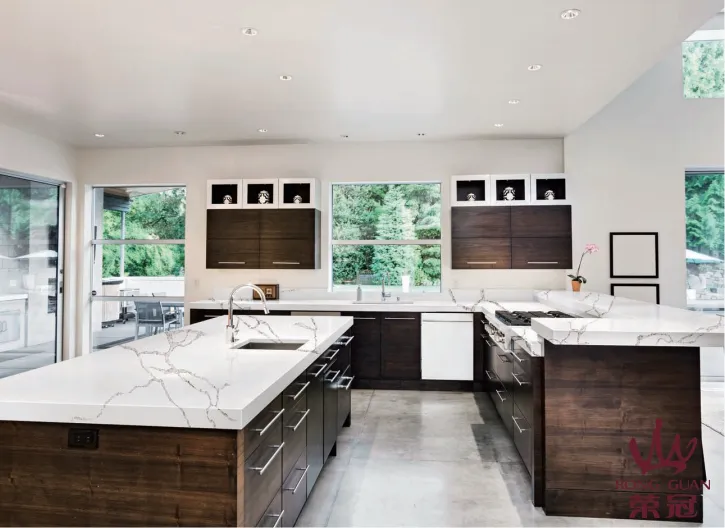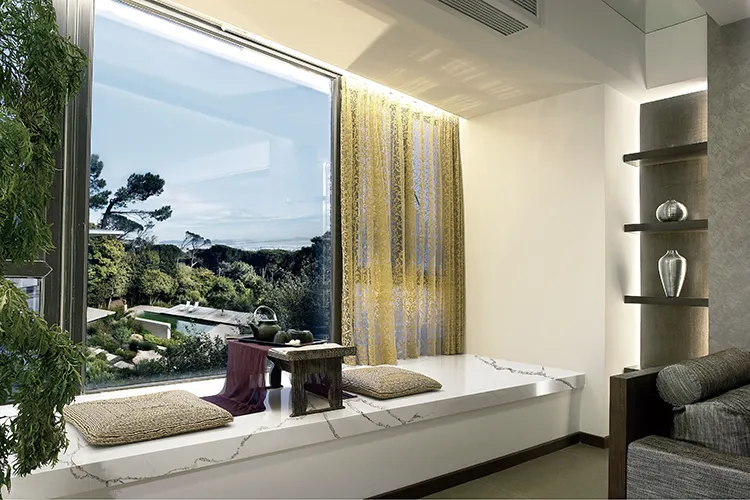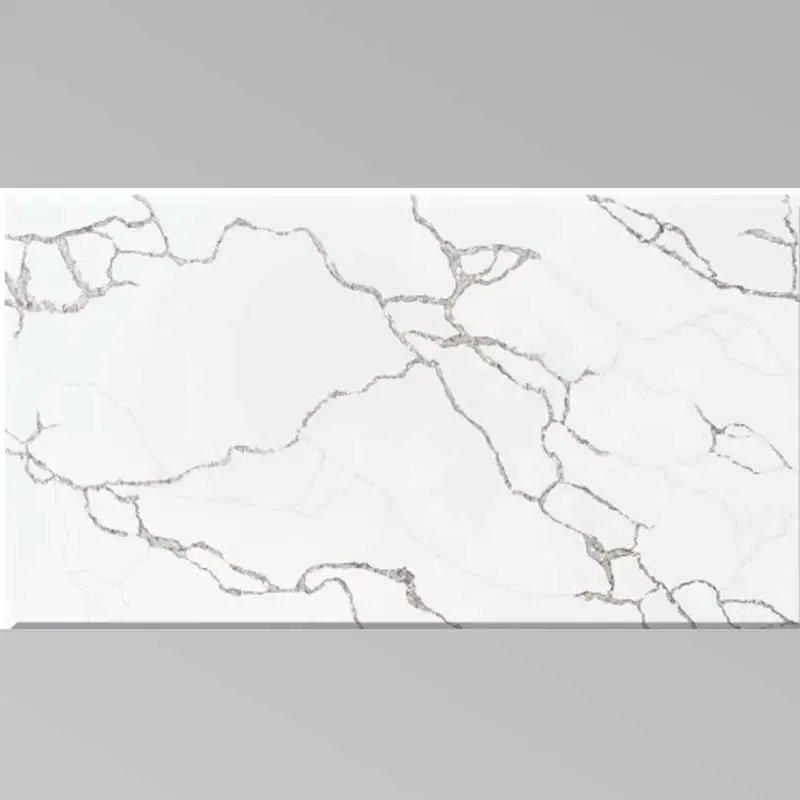In modern home decoration, Calacatta quartz countertops have become an ideal choice for kitchens and bathrooms due to their elegant appearance and excellent performance, especially white Calacatta quartz countertops, which bring a modern and high-end feel to the space with their clean and bright tones. However, many users will find that white Calacatta quartz countertops gradually turn yellow after long-term use. This problem not only affects the appearance, but also may cause people to worry about the service life and performance of the countertop.
So why do white Calacatta quartz countertops turn yellow? This is the result of a combination of factors, involving material properties, daily use environment, cleaning habits, etc. This article will explore in depth the reasons that cause Calacatta quartz countertops to turn yellow, and provide corresponding prevention and treatment methods to help consumers extend the service life of the countertops and maintain their beauty.

What is a Calacatta quartz countertop?
Calacatta quartz countertops are a type of artificial quartz stone designed with inspiration from the natural marble Calacatta. It is mainly white with veins such as gold, gray or black, which gives the countertop a natural stone texture and the high hardness and durability of quartz. Because the appearance of Calacatta quartz countertops is very similar to natural marble, and it has the advantages of anti-fouling, scratch resistance and easy cleaning, it is widely loved by consumers.
However, although Calacatta quartz countertops have many advantages, they are not without disadvantages. White Calacatta quartz countertops are particularly susceptible to external factors, especially in the high-frequency use environment of the kitchen, where the countertops are easily exposed to various liquids, oil stains and dirt, all of which may cause the countertops to change color, especially yellowing.
Why does my white Calacatta quartz countertop turn yellow?
1. Ultraviolet exposure
Ultraviolet rays are one of the main reasons for the yellowing of white Calacatta quartz countertops. Calacatta quartz countertops are made of a mixture of natural quartz and resin, and the resin part is more sensitive to ultraviolet rays. When the countertop is exposed to sunlight for a long time, especially in an environment with strong ultraviolet rays, the resin part will undergo oxidation, causing its color to turn yellow. Although modern Calacatta quartz countertops have enhanced the UV resistance of the resin through technical means, they will still show some discoloration when exposed to strong light for a long time.
2. Improper cleaning or use of improper detergents
Although quartz countertops have strong stain resistance, if unsuitable detergents are used, especially those containing strong acids, strong alkalis or bleaching ingredients, they will also cause certain damage to the countertop surface. For example, some detergents contain hydrogen peroxide or chloride ingredients, which will cause chemical reactions in the resin part of the countertop, eventually causing the countertop to turn yellow. In addition, excessive wiping of the countertop or using rough cleaning tools (such as steel wool) may also scratch the surface, making the countertop more susceptible to stains, and long-term accumulation will form yellowing.
3. Oil stains and food residues
The Calacatta quartz countertops in the kitchen are often in direct contact with food, oil stains and other substances. Especially when cooking, grease and chemical components in food are easy to adhere to the surface of the countertop. Although quartz countertops have a certain degree of stain resistance, if they are not cleaned in time, these oil stains and stains will penetrate the surface of the countertop and cause discoloration, especially yellow oil stains and juice, which can easily leave marks on white countertops, making the countertop appear yellow.
4. High temperature and contact with hot objects
High temperature is another factor that may cause Calacatta quartz countertops to turn yellow. Although quartz countertops have good heat resistance, long-term direct contact with high-temperature objects, especially extreme high temperatures, will still affect the surface. High temperatures may cause oxidation reactions in the resin part, causing the countertop to discolor. In addition, if hot pots, hot pans and other items are placed on the countertop, especially without a protective pad, the part that is in direct contact with the countertop may turn yellow, especially on white countertops.
5. Pollutants and chemicals in the air
Potents, chemicals, dust, etc. in the air may also be potential factors that cause Calacatta quartz countertops to turn yellow. Especially in some industrial or highly polluted environments, harmful substances and dust in the air will adhere to the surface of the countertop and gradually accumulate, causing discoloration. Especially in humid and poorly ventilated environments, moisture and chemical components in the air may react with the countertop surface, affecting the color stability and causing yellowing.
6. Aging and the influence of time
Over time, the resin part of the surface of the Calacatta quartz countertop may also undergo a natural aging process, especially in the case of long-term use, the material will be affected by different external factors. As the resin ages, the countertop may develop tiny cracks or discoloration. This is a slow and inevitable process, especially in the case of frequent exposure to high temperatures or chemicals, the aging process may accelerate, causing yellowing.

How to prevent and solve the problem of yellowing of white Calacatta quartz countertops?
Although the phenomenon of yellowing of Calacatta quartz countertops is relatively common, consumers can delay the occurrence of this problem or even solve it through some effective prevention and treatment methods. Here are some common preventive measures and solutions:
1. Avoid direct sunlight
To avoid the influence of ultraviolet rays, try to avoid exposing Calacatta quartz countertops to strong sunlight. Especially for large areas of white countertops, direct sunlight can easily cause the countertop surface to fade and yellow. If conditions permit, use curtains or blinds to block the sun, or install a UV-protective film on the countertop.
2. Choose a mild detergent
For daily cleaning, choose a mild, non-corrosive detergent and avoid using detergents containing bleach, strong acids or strong alkalis. Neutral detergents or detergents designed for quartz countertops can be used. These products can effectively remove stains without damaging the surface of the countertop. In addition, use a soft cloth or sponge for cleaning, and avoid using hard cleaning tools such as steel wool.
3. Clean oil stains and stains regularly
In order to prevent oil stains and other food residues from causing the countertop to turn yellow, oil stains, stains and liquids on the countertop should be cleaned in time. Especially during cooking, oil smoke and food residues are easy to adhere to the countertop, so be sure to clean it in a short time. Use a damp cloth or neutral detergent to wipe gently to prevent oil stains from accumulating and penetrating the surface.
4. Avoid high-temperature objects from directly contacting the countertop
Try to avoid placing high-temperature objects such as hot pots and hot pans directly on the countertop. If you need to place hot items, it is recommended to use heat-insulating tools such as pot holders and hot pads to prevent high temperatures from damaging the countertops.
5. Regular maintenance and professional cleaning
Regular professional cleaning and maintenance can help slow the aging process of Calacatta quartz countertops. Some quartz countertop brands offer specialized maintenance services that can effectively clean deep stains on the countertops and polish the surface to restore the gloss of the countertops.

Rongguan is your reliable supplier of high-quality building materials, offering everything from artificial marble countertops to clay roofing tiles. With our advanced factory and over 300,000 square meters of production space, we ensure fast and efficient production of customized solutions at affordable prices. Our wholesale rates and discounts make us the ideal choice for large-scale projects, while our focus on quality ensures every product exceeds expectations. Contact us for quotes and to learn about our latest promotions.

